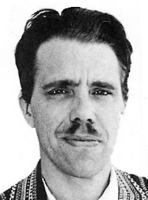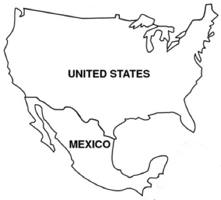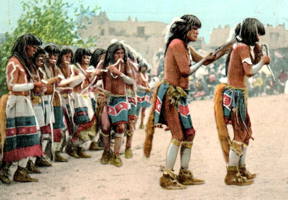
|
The Society of Folk Dance Historians (SFDH)
Native American Affairs
[
Home |
About |
Encyclopedia | CLICK AN IMAGE TO ENLARGE |

|
 To use the term "tribe" in referring to any of the Native American groups of peoples of North America is as inapplicable as doing the same when speaking of those of Europe, Asia, or even the South Pacific. You do not hear of the Irish tribe, or the Greek tribe, Croatian tribe, Norwegian tribe, Ukrainian tribe, Tongan tribe, Japanese tribe, or Armenian tribe – they are nations – "aggregations of persons of the same ethnic family, speaking the same language or cognate languages . . . a body of people associated with a particular territory who are sufficiently conscious of their unity to seek or possess a government peculiarity their own . . ."
To use the term "tribe" in referring to any of the Native American groups of peoples of North America is as inapplicable as doing the same when speaking of those of Europe, Asia, or even the South Pacific. You do not hear of the Irish tribe, or the Greek tribe, Croatian tribe, Norwegian tribe, Ukrainian tribe, Tongan tribe, Japanese tribe, or Armenian tribe – they are nations – "aggregations of persons of the same ethnic family, speaking the same language or cognate languages . . . a body of people associated with a particular territory who are sufficiently conscious of their unity to seek or possess a government peculiarity their own . . ."
In North America, there were, at the time of the coming of the Caucasian, and probably still are, more nations, aggregations of persons, satisfying these qualifications than on any other continent except perhaps Africa. They are the nations, great and small, collectively referred to as Native American.
Like the Indo-European, Finno-Ugric, and Semitic language groups of the old world, there are great language families in America – the Algonquins, Athabaskan, Dakotas, and so on. All of the nations within these families have at some point in time had their place of importance in the scheme of things, and some because of story or legend, noted leaders, development, or conflict with the United States government and settlers (rarely Canadian or Mexican), have become far more well known. Some examples are the Iroquois Confederacy and the Cherokees of the eastern woodlands, the Sioux of the plains, the southeastern Seminoles, the Athabaskan, southwestern Navajos and Apaches, the Zunis of the pueblos, and the Nez-Perce nations of the northwest. As with any ethnic group anywhere, customs, diet, dance, music, housing, instruments, and dress have been adopted to the environment.
The dances of the southwestern United States and northern Mexico have remained relatively pure and according to early tradition. Some have been influenced by contact with other Native American nations as well as with Anglo-American and Spanish-Mexican culture (here, often with religious overtones). Basically though, the animal and harvest dances of the Pueblos, the "Shalako" of the Zuni, the "Yei-bei-chi" of the Navajo, remain pure. These the white man has not yet taken away from him and it is the intention of the Native American that such remains the case. Many Native American festivities are absolutely closed to the outsider, and in those that are not, the guest may watch only. The Navajo Nation issued a proclamation, which was published in "Arizona Highways," that at first seemed highly uncalled for, considering the fact that the magazine has probably done more to promote and encourage, as well as publicize, the culture of the southwestern Native Americans. On second thought though, it was apparent that the manifesto was not directed at any specific individual or organization; it was an attempt to preserve a precious culture from exploitation, not by "Arizona Highways," but by those types who barge into a village wedding in Slavonia and want to buy the shirt off the groom's back; tape a song in Balkanton and arrange it into the Verbunk Rock;" or choreograph a Polonaise from Poznan into a mini-skirted, high-kicking travesty of its original . . . so much for sermonizing!
Other Native American nations have done some borrowing back and forth. The mask dances of the eastern woodlands are examples. Quite some similarity is found throughout inasmuch as most seem to be methods to ward off evil spirits, either by frightening them away, or as use as a disguise so the dancers won't be recognized. The Cherokees of western North Carolina have many mask dances. The northern Iroquois have their "false face society" and its quite grotesque dances. Others will be found in Arizona, New Mexico, and the northwest.
 In the villages of the Hopi, an annual event is the Snake Dance. The Kachina dances, also of the Hopi, as well as the Zuni, are traditional, heavily costumed, mask-type dances. A very noted dance is the Deer Dance of the Yaquis of Sonora and Arizona, which combines traditional cultural movements and meanings with motions and symbols derived from Spanish and Catholic contacts. Hoop Dances seem to be legion. Authorities seem to differ as to whether Hoop Dances came from the Navajo regions or the Native Americans of the plains. Perhaps both came from still another source. Certainly, the dances are impressive with all the motions through the hoops, and apparently there was no hesitance about borrowing the idea.
In the villages of the Hopi, an annual event is the Snake Dance. The Kachina dances, also of the Hopi, as well as the Zuni, are traditional, heavily costumed, mask-type dances. A very noted dance is the Deer Dance of the Yaquis of Sonora and Arizona, which combines traditional cultural movements and meanings with motions and symbols derived from Spanish and Catholic contacts. Hoop Dances seem to be legion. Authorities seem to differ as to whether Hoop Dances came from the Navajo regions or the Native Americans of the plains. Perhaps both came from still another source. Certainly, the dances are impressive with all the motions through the hoops, and apparently there was no hesitance about borrowing the idea.
On of the most famous dances is the Sun Dance, especially the one danced by the Oglala Sioux. It is danced on the reservations of South Dakota, principally at Pine Ridge and Rosebud, and actually has nothing to do with the sun. It is held in late June or early July, according to the phases of the moon and is perhaps more of a torture or endurance dance. The male dancer has a cord skewered through sinews in his chest, the other ends tied to a pole, and he leans back, gazing at the sun (hence its name?). Various motions and chantings go on, and possibly he will faint with pain or the cord will tear out. Forbidden for many years, it was restored in the early 1940s and became a part of the spectacle, open to the public about 1965, but without skewering the chest. The public is not permitted to participate, and frankly, we doubt that many wish to.
Before the coming of the European invaders, groups of people speaking a Souix tongue lived in the area between the Ohio River and the Great Lakes, and to their north and the east were Ojibways and Iroquois. In the same manner as the nomads from Central Asia swept into Europe, pushing ahead of them the inhabitants of the lands, who in turn moved westward doing the same thing, so it was in North America. These Sioux, or properly, Dakotahs (the term meaning "an alliance of friends"), moved westward, displacing other Native American nations in Minnesota, then the Dakota and Montana areas. Depending upon dialect, these people of Sioux background were divided into three loose divisions: the "Dakotah," the "Lakotah," and the "Nakotah." Four sub-groups formed the Dakotahs, the "Santee" (Sisseton, Waheton, Wahpekdte, and Mewankton) or eastern Sioux; the two "Yanktons" were the Middle or Nakotah Sioux; the "Prairie" or "Tetons" (Lakotah) were the largest division by far, with seven lesser divisions of which the "Brules" and the "Oglalas" are by far the best known because of their noted warriors, their length of independence, and their confrontations with the advancing American pioneers.
Red Cloud, Crazy Horse, Sitting Bull, and the great Brule leaders, Spotted Tail and Hollow Horn Bear, and their associations with Ft. Laramie, Custer, and the battles of Little Big Horn and Wounded Knee: all of these people, their leaders, and events were associated with the area of South Dakota and its periphery, and with the war strongest and most prolonged, both culturally and militarily, within the confines of the United States, with the exception of the War Between the States and its immediate aftermath. The Sioux nation is living and well and proud, and many of them are on the reservations including the Lower Brule, Pine Ridge, Rosebud, and Cheyenne in the Dakotas.
DOCUMENTS
- Native American, a culture.
- Native American Dance, an article.
- Native American Dances, an article.
- Navaho Tradition Keepers, an article.
- North America, a region.
Used with permission of the author.
Printed in Folk Dance Scene, September 1976.
This page © 2018 by Ron Houston.
Please do not copy any part of this page without including this copyright notice.
Please do not copy small portions out of context.
Please do not copy large portions without permission from Ron Houston.